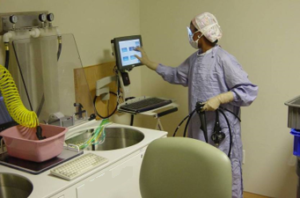 Hospitals and healthcare providers are under increased scrutiny by The Joint Commission (TJC), the FDA, DNV and even Congress to improve the documentation practices around flexible endoscope usage. There are articles are in the media seemingly every day about how a hospital was cited, sued or otherwise put in a negative light around their endoscope practices. No hospital wants this and staff that work at hospitals don’t deserve this.
Hospitals and healthcare providers are under increased scrutiny by The Joint Commission (TJC), the FDA, DNV and even Congress to improve the documentation practices around flexible endoscope usage. There are articles are in the media seemingly every day about how a hospital was cited, sued or otherwise put in a negative light around their endoscope practices. No hospital wants this and staff that work at hospitals don’t deserve this.
The best way to defend against being put in a negative light, and to improve safety practices in general, is through great documentation. High fidelity documentation eliminates concerns by surveyors and regulators, ensures staff are trained and following quality checklists and procedures, and provides data that can help your hospital improve operations over time.
In our study of the hospital market, we are seeing some hospitals are starting to use their automated endoscope reprocessors (“AER”) as their scope documentation system. Though we applaud the move from pen and paper (and other methods) to a system, there are various reasons that this does not suffice if your objective is to increase safety and infection control conditions for your patients and your staff.
1) AER usage is at the end of the process
The AER only tells you that a certain scope has been high level disinfected by the AER. It doesn’t tell you anything else about the cycle of the scope from storage, to use at the bedside, to pre-clean and all the other steps prior to reprocessing. Further, by being at the end of the cycle, it is difficult for team members in the scope area to know exactly which patient the scope was used on and at what time.
Additionally, best practices today dictate that the enzymatic cleaner should be on the scope within one hour of use. An AER does not provide any such data or proactive alerts to your team. Missing this step creates a large risk of infection or worse for your future patients and team members.
2) The AER doesn’t know hang time
Hospitals are moving from more conservative 30 and 14 day hangtimes for scopes, to more aggressive 7 and 5 day hangtimes across a large sample of hospitals that we’ve talked to recently – over 50% of hospitals are now at 14 days or less. An AER does not know which scopes have been removed for use or are still hanging ready to be used. No alerting or data is available for team members to eliminate issues.
3) The AER is standalone
AERs are not connected to the IT and medical record infrastructure your hospital has invested in. The information in an AER sits in a silo and is often difficult to download and analyze. In the modern healthcare world, all systems need to be interconnected so that healthcare providers can see an entire view of the patient across their health system.
4) The AER was designed for just that – “Reprocessing”
No doubt, AERs are great at what they are designed to do – automate the reprocessing of scopes. We applaud the improvement in reprocessing technology and the investment hospitals are making in constantly upgrading AER effectiveness. Let the AER do what it does best and let the hospital invest in an appropriate process to document the entire lifecycle of the scope.
If your hospital has objectives to deliver the highest quality of care, safety and performance, a world-class AER should be part of the overall strategy. It should not be the entire documentation system. It leaves too many holes in the data, it requires a lot of manual data entry, it makes it difficult to analyze the data, and it doesn’t provide information about the entire lifecycle of the scope.
Whether it’s with iRIScope or other off-the-shelf systems, or a design of your own in your hospital, we encourage all hospitals to implement a whole lifecycle documentation system for endoscope documentation and management. This is a best practice for meeting the increasing scrutiny in scope management being brought by regulatory agencies, driving quality procedures and checklists with your staff, and improving operations over time. That is an improvement in quality we can all be proud of.
